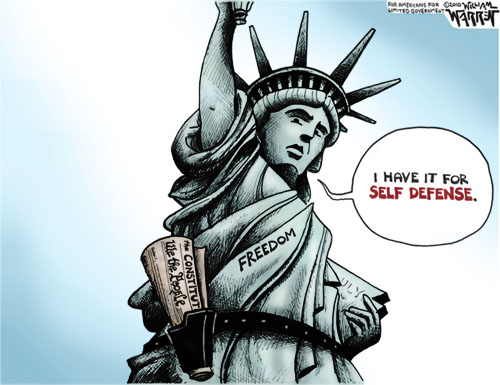By Natalia Castro
As liberals around the country celebrate Whole Women’s Health v. Hellerstedt, a decisively pro-choice Supreme Court ruling on abortion, they may want to consider how the precedent set would apply to gun rights.
Whole Women’s Health v. Hellerstedt was a 5-3 decision ruling on the concept of the “undue burden” originally established in Roe v. Wade. Roe stated, “a state has a legitimate interest in seeing to it that abortion is performed under circumstances that insure maximum safety for the patient… a statute which has the effect of placing a substantial obstacle in the path of a woman’s choice cannot be considered a permissible means of serving its legitimate ends.”
In the most recent decision, the Court ruled that Texas’ law placed too much of an obstacle to getting an abortion, reaffirming that no obstacle, such as requiring clinics to meet ambulance surgery center standards, may be used to limit this right.
But abortion is not an explicit right under the Constitution. Still, the Supreme Court refuses to allow any burden to prevent it from being exercised. The Justices continue to treat the right to abortion as a right equal in strength to the right to due process, trial by jury or free speech.
By this logic, then, federal courts should equally treat the right to keep and bear arms, a fundamental right actually included in the Constitution’s Second Amendment, with the same level of respect.
When Judge Myron Thompson wrote his decision in Planned Parenthood Southeast v. Luther Strange in the Middle District of Alabama, he explained this correlation. Writing “at its core, each protected right is held by the individual: the right to decide to have an abortion and the right to have and use firearms for self-defense. In the context of both rights, the Supreme Court recognizes that some regulation of the protected activity is appropriate, but that other regulation may tread too heavily on the right.”
He explains that since both inherently involve other individuals or potential individuals, there is a level of supervision but, in his view, any effort to deliberately prevent an abortion is as unjust as preventing gun ownership.
Now to be consistent the Supreme Court must use the logic they used in Hellerstedt once again, this time in the 9th Circuit Appeals case Peruta v. San Diego, which denies individuals the ability to carry concealed weapons without adhering to strict criteria which changes from county to county.
Arbitrary guidelines like “good moral character,” and demonstrating “good cause” outside of simply self-defense or self-interest are vague burdens governments against gun rights impose to prevent ownership. In abortion cases the Supreme Court ruled burdens just like these which are used to limit abortion rights are unconstitutional, the rulings dealing with the right of gun ownership must be viewed by the same standard.
The next Supreme Court docket will likely include the Peruta case, making it more important than ever that the Justice replacing the late Justice Scalia be one to vote in consistency with the fundamental right of being pro-choice on gun ownership.
In the last major gun rights case, D.C. v. Heller it was Justices Scalia, Roberts, Kennedy, Thomas, and Alito all voting in favor of the Second Amendment right to keep and bear arms as an individual right. However, with Scalia’s passing it is more feasible than ever that if, for example, Hillary Clinton the presumed Democratic nominee, is elected president all of these established precedents protecting gun rights will be thrown away with a 5-4 decision against the second amendment.
Our next president will not just have power over the executive office but the fundamental rights of the Second Amendment to be practiced without undue burden.
Natalia Castro is a contributing editor at Americans for Limited Government.







